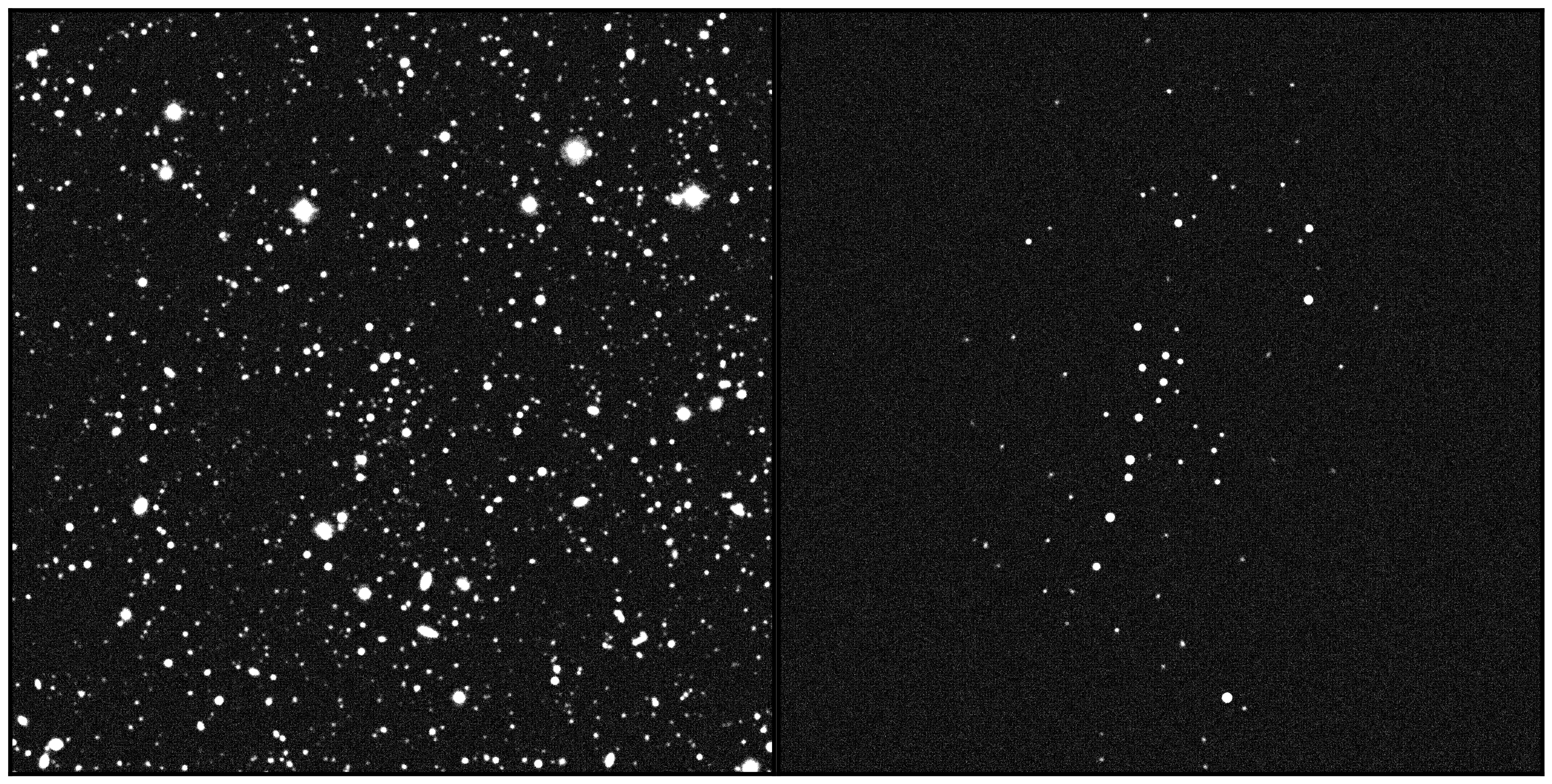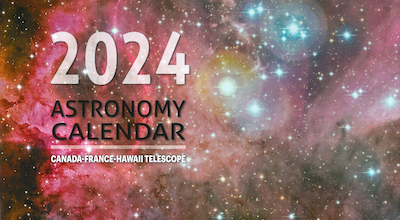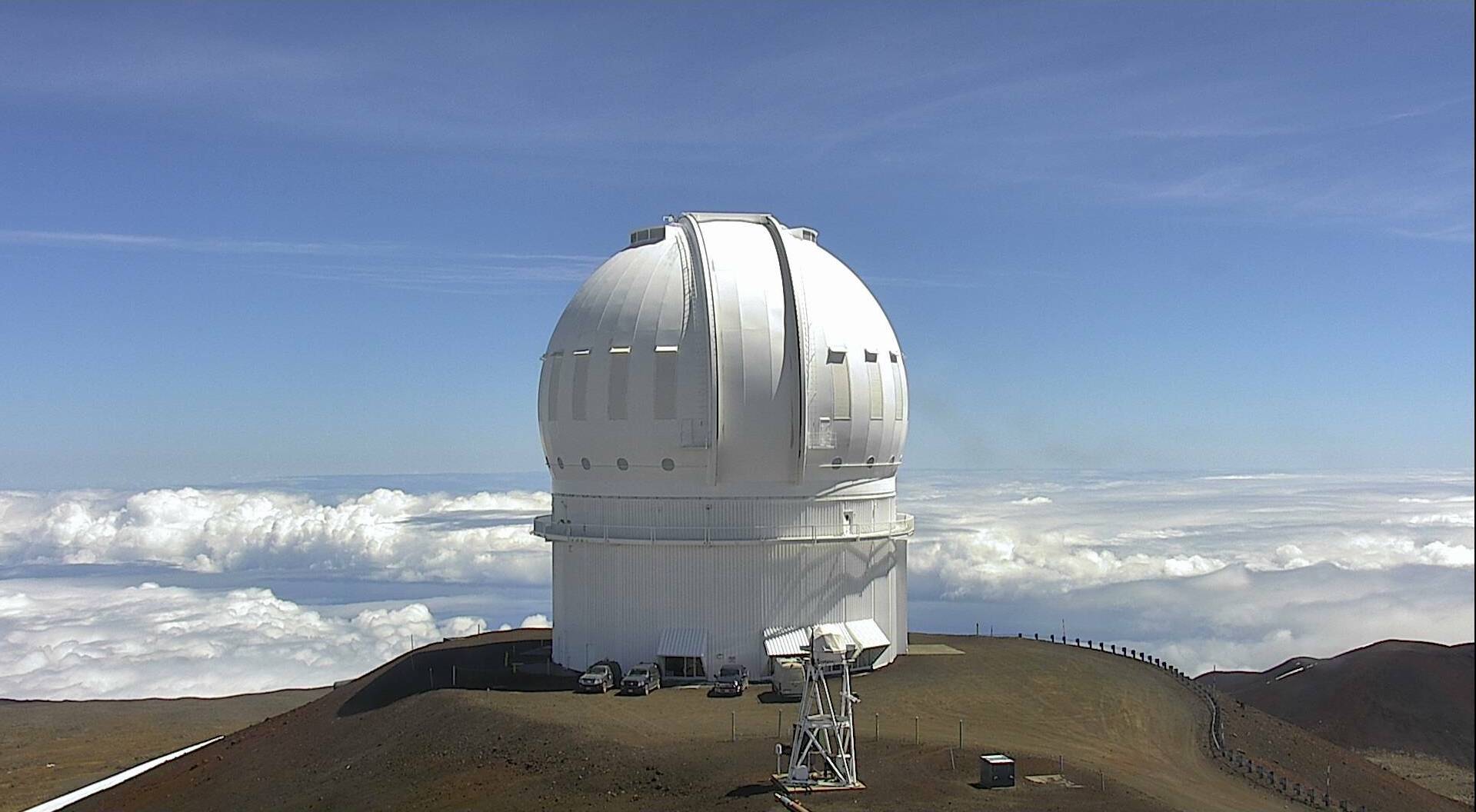Lens modeling with Maunakea Observatories leads to an independant high precision measurement of the Hubble constant.
An international team of Astronomers from the H0LiCOW collaboration led by Sherry Suyu (Max Planck Institute for Astrophysics in Germany, the ASIAA in Taiwan and the Technical University of Munich) used telescopes in space, in Chile, on Maunakea and in Europe to measure time delays between lensed images in a gravitational lensing system. This allowed for an independant measurement of the speed of the expansion of the Universe or the Hubble constant. This measurement is in agreement with other measurements made in the local Universe but disagrees with measurements made in the early Universe thus reviving an old debate in astronomy about the speed of the expansion of the Universe.
Objects with large masses such as galaxies or clusters of galaxies warp the spacetime surrounding them in such a way that they can create multiple images of background objects. This effect is called strong gravitational lensing. Credits: ESA/Hubble, NASA
|
Objects with large masses such as galaxies or clusters of galaxies warp the spacetime surrounding them in such a way that they can create multiple images of background objects. This effect is called strong gravitational lensing. Credits: ESA/Hubble, NASA
|
Gravitational lensing was first predicted by Albert Einstein more than a century ago and states that when light from distant objects passes near a closer but massive object, the light from distant objects is bent and distorts their images as seen from Earth. If, for example, a distant quasar is almost perfectly aligned with a closer galaxy and Earth, it creates what is called an Einstein ring. This ring is mostly made of multiple images of the well aligned quasar. This phenomenon is called strong lensing. However, other background objects located farther away from the line of sight to the lens will also contribute to the distortion produced by the lens and produce a weaker distortion that contributes to the distortion caused by strong lensing.
HE 0435−1223 is a distant quasar lensed by a galaxy. Since the quasar, lensing galaxy and Earth are well aligned, four images of the quasar are visible. Because distortions in the fabric of space-time created by galaxies are not perfectly spherical and the lensing galaxy and quasar are not perfectly aligned with Earth, the light from the different images of the background quasar follows paths which have slightly different lengths. Since the brightness of quasars changes over time, astronomers can see the different images of the same quasar flicker at different times. These time delays as well as the distortions caused by the lens can be directly related to the value of the Hubble constant. "Our method is the most simple and direct way to measure the Hubble constant as it only uses geometry and General Relativity, no other assumptions", explains co-lead Frédéric Courbin from EPFL, Switzerland.
An impressive list of resources was needed to measure the time delays between the four images of the quasar. The team used not only the Hubble Space Telescope and the Spitzer Space Telescope but also the W.M. Keck Observatory, ESO’s Very Large Telescope, Subaru, Gemini, CFHT, the Victor M. Blanco Telescope, the Swiss 1.2-metre Leonhard Euler Telescope and the MPG/ESO 2.2-meter telescope.
The wide field capabilities of CFHT, Subaru, Gemini and the Spitzer Space Telescope as well as the deep spectroscopic capabilities of the W.M. Keck Observatory were used to determine which galaxies were contributing to the weaker gravitational lensing signal. This was necessary because a greater knowledge of the galaxies that contribute to lensing was needed to have a more precise determination of the Hubble constant. Once the lens model was complete, the team used precise photometric monitoring of the four quasar images in HE 0435−1223 to measure time differences between the variations of the brightness of quasar images to yield an impressively high precision of 3.8% on the derived value of the Hubble constant. "An accurate measurement of the Hubble constant is one of the most sought-after prizes in cosmological research today", highlights team member Vivien Bonvin, from EPFL, Switzerland. Suyu adds: "The Hubble constant is crucial for modern astronomy as it can help to confirm or refute whether our picture of the Universe — composed of dark energy, dark matter and normal matter — is actually correct, or if we are missing something fundamental".
The new measurement is completely independent of — but in excellent agreement with — other measurements of the Hubble constant in the local Universe that used Cepheid variable stars and supernovae as points of reference. The H0LiCOW team determined a value for the Hubble constant of 71.9±2.7 kilometres per second per Megaparsec. In 2016 scientists using Hubble measured a value of 73.24±1.74 kilometres per second per Megaparsec. However, the value measured using this new technique, as well as those measured using Cepheids and supernovae, are different from the measurement made by the ESA Planck satellite which measured the constant with the highest precision so far and obtained a value of 66.93±0.62 kilometres per second per Megaparsec. There is an important distinction in these measurements — Planck measured the Hubble constant for the early Universe by observing the cosmic microwave background. All the methods cited above have one thing in common, their measurements are made at a high level of precision. "The expansion rate of the Universe is now starting to be measured in different ways with such high precision that actual discrepancies may possibly point towards new physics beyond our current knowledge of the Universe", concludes Suyu.
Additional information
Hubble/ESO press releaseSubaru press release
Science paper I
Science paper II
Science paper III
Science paper IV
Science paper V
H0LiCOW collaboration.
Media contact:
Mary Beth LaychakCanada-France-Hawaii Telescope
Waimea, Hawaii
Tel: (808) 885-7944
Email:mary@cfht.hawaii.edu
Science contacts:
Sherry SuyuMax Planck Institute for Astrophysics, the ASIAA in Taiwan and the Technical University of Munich
Garching, Germany
Tel: +49 89 30000 2015
Email: suyu@mpa-garching.mpg.de
Vivien Bonvin
Institute of Physics, Laboratory of Astrophysics, Ecole Polytechnique Fédérale de Lausanne (EPFL), Observatory of Sauverny
Versoix, Switzerland
Tel: +41 22 3792420
Email: vivien.bonvin@epfl.ch
Frederic Courbin
Institute of Physics, Laboratory of Astrophysics, Ecole Polytechnique Fédérale de Lausanne (EPFL), Observatory of Sauverny
Versoix, Switzerland
Tel: +41 22 3792418
Email: frederic.courbin@epfl.ch
Mathias Jäger
ESA/Hubble, Public Information Officer
Garching, Germany
Tel: +49 176 62397500
Email: hubble@eso.org





